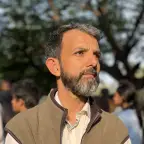
The next day, we woke up leisurely and had a wonderful breakfast. Our host meticulously wrote down all the attractions near Madikeri. The list included Tala-Cauvery – the birthplace of the river Kaveri, Raja Seat, Abby Falls, Omkareshwara Temple, and Cauvery-Nisargadhama. We decided on all except the last one, as we wanted to take it easy and not rush between attractions.
As soon as we started driving to Madikeri (the district headquarters of Coorg), the real beauty of Coorg started to unveil itself. The air was clean, fresh but a bit chilled. The lush green hills with teak trees and coffee plantations rejuvenated our eyes and mind. Coorg is in the Western Ghats of India and above 1500 m, making this place cooler throughout the year. Locals call Madikeri the Scotland of the East (in the North East, Shillong is referred to as the Scotland of India).
There are numerous coffee plantations of various sizes, ranging from a few acres to hundreds. Alongside coffee, there are other plantations like orange, pepper, and nutmeg. Almost every plantation has one or more streams for water, and all these streams join the Cauvery as they descend. Currently, the biggest challenges are labor shortages, as traditional laborers are migrating to urban areas for better-paying jobs and lifestyles.
Heading towards Tala-Cauvery, past Madikeri, it resembled a small hill town of the North East, with houses painted in bright colors perched on hills. This route leads to Mangalore. Being a weekday, there were not many cars towards Tala-Cauvery. Tala Cauvery is around 40 KM from Madikeri. On the way, we took a few stops to shoot pictures with a clear blue sky. Only a few days back, there was a Marathon (42.24KM), and the road was marked with distances from the finish line. The last part of the road was a straight uphill climb from Bhagamandala. Bhagamandala is supposed to be the sangam of three rivers; Cauvery and the Kanika are the real ones, while the third one is invisible (mythical). There is a temple, but we did not stop and continued to the final destination through winding roads.
There is a pond that signifies the origin of the Cauvery. It’s situated on the slopes of Brahmagiri hills. Every year during Makar Sankranti, the pond overflows with water, and devotees collect it as holy water. There are steps that take you to the peak and give a bird’s eye view of the temple and pond from there. I took Aarush in a Kangaroo-sling, and he cooperated. It was very windy at the top, which forced us to come down quickly.
On the way back, we had lunch at East End Hotel on the highway towards Mysore, next to the petrol station. We ordered some rice and chicken curry (Kodava style). The ambiance is ordinary but crowded, which means it is a popular destination and a safe place for dining.
After lunch, we headed for Raja Seat but somehow missed it the first time and had to make a U-turn to come back. Former kings watched the sunsets with their loved ones from this place. The curved road to Mangalore under the valley adds magnificently to the hills, green valleys, studded with paddy fields in the background. There is a toy train that was not running at that hour for kids and families.
From there, we went to Omkareshwara Temple; this is within Madikeri town. It was built by Lingarajendra II in 1820 in the combination of Catholic, Keralite, Gothic, and Islamic styles of Architecture. We could not enter the temple as it was closed during the afternoon.
After that, we rushed to Abbey Falls, going back towards Mysore road and taking a left from the highway. In the local language, Abbey itself means falls, so a literal translation will be falls falls. This road is winding and narrow, and we needed to keep on driving as the Sun was dipping quickly. This falls is located within a private property but open to the public. Aarush took a quick short nap in this part. Soon, the roaring water woke him up. It was a delight to find plenty of water during the dry months of December. During the monsoon season from July to October, it must be flowing like a torrent. The view from the hanging bridge is quite enjoyable. The cascading water descends to the river Cauvery.
Headed back to the homestay before it was completely dark. The next day morning, we were not sure what to do (as Nagarhole and Dubare will not be enjoyable for Aarush) and ultimately decided to head back to Bangalore. We came back to Mysore, spent a good amount of time around the main market area and Ramkrishna Mission. Around dusk, we left Mysore so that we could reach Bangalore a bit late, avoiding the evening rush traffic.
The bottom line is you can visit Coorg all year round if you love rain or avoid monsoon, as it rains a lot in the Western Ghats. Getting out of Bangalore is really difficult, but leaving a place like this is very painful after a nice trip.
Some links:
Read Next
Little Tibet
The Little Tibetian Home In South India
2008 - mixed bag
Looking back at 2008
